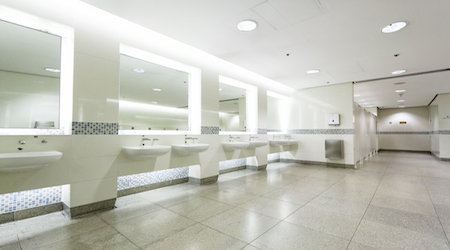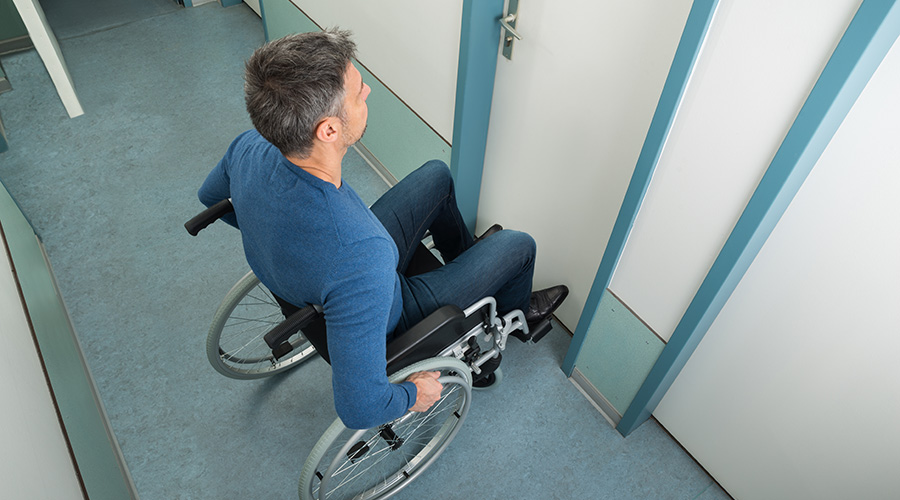When Doing Interior Retrofits, Complying With ADA Is Critical
Part 1 of a 2-part article on ADA requirements in office space, restrooms, and common areas.
As you look to retrofit existing facilities — whether in office space, restrooms, or common areas — complying with the Americans with Disabilities Act (ADA) is a critical, non-negotiable consideration. ADA, which turned 25 in 2015, was updated in 2010, and it’s important to ensure that any interior retrofit meets the latest standards.
The ADA requirements have been in effect since Jan. 26, 1992. How many times have you done renovations, alterations, or new construction in these past 24 years? Let’s go through the thought and planning process when you renovate or alter primary function areas and what the ADA requirements are for those projects.
For existing buildings, ADA is unlike building code; it requires that readily achievable barrier removal be performed on an ongoing basis. (This began as well on Jan. 26, 1992.) Renovations and alterations to primary function areas have increased/heightened requirements for compliance.
They include: All items, elements, and spaces that are being renovated must be modified to comply with the 2010 ADA Standards for Accessible Design.
If fire/life safety systems are being installed or updated, they must comply with applicable provisions of NFPA 72 or state fire codes, whichever provides for a greater degree of protection.
Elements that are not included in ADA requirements include wall covering, lighting, and acoustics.
Important changes from the 2010 ADA Standards for Accessible Design will have significant impact on your renovations, particularly in restrooms. Clear floor space has been expanded in both single-user toilet rooms and restroom accessible stalls. This will have an impact when you are renovating your restrooms because you will not be able to simply replace a water closet that is currently placed adjacent or close to a lavatory. If your existing accessible stall happens to have a lavatory within the stall, the easy fix is to remove the lavatory. There is nothing written in the ADA that requires an accessible toilet stall to have a lavatory located within the stall.
Dispensers (paper towel, feminine items, toilet seat covers, etc.) must now have their highest operating control at 48 inches above finish floor (AFF). Operating control mounting height also includes light switches and electrical outlets.
Path of Travel
Path of travel is another a huge consideration when doing renovations or alterations. Both building code and the ADA require removal of barriers that exist on the path of travel to the renovated space. A maximum of 20 percent of the total/final construction budget must be spent on the barrier removal.
The path of travel includes:
1. Parking lot
2. Exterior sidewalks/curb ramps
3. Entrance(s)
4. Interior path of travel (stairs, elevator, hallways, etc.) to renovated space(s)
5. Restroom(s)
6. Water fountain(s)
While parking lots are a low priority for renovations as far as the ADA is concerned, a considerable amount of litigation has focused on “drive-by” lawsuits. So if your parking lot (designated accessible parking spaces, access aisles, curb ramps, sidewalks, and ramps) and entrances do not comply with the ADA, this should receive your immediate attention.
If you have money left (particularly from large projects), ensure that you remove barriers on the interior path of travel. Often overlooked are protruding objects (wall sconces that protrude more than 4 inches from the wall) that are barriers to individuals with visual disabilities, or lack of strobe alarms in hallways that are barriers to individuals with hearing disabilities.
In elevators, if you still have two-way emergency communications that require voice, have your elevator company replace them with one that uses a light to signal that the call has been received. This is critical for individuals with speech or hearing disabilities.
Don’t forget door hardware. If renovations are being made to any rooms, the door is part of the path of travel. Make sure you replace doorknobs with lever operators.
Related Topics:













